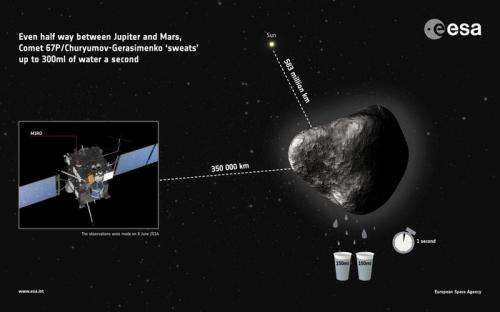Distant comet 'sweats' two glasses of water per second

Unprecedented measurement of a deep-space comet has found the icy body to be losing about two small glasses of water every second, the European Space Agency (ESA) said on Monday.
ESA's probe, Rosetta, made the measurements on June 6, when it aimed a microwave sensor at Comet 67P/ Churyumov-Gerasimenko, on which it will land a probe in August after a 10-year space trek.
It found the comet lost 300 millilitres (10.5 fluid ounces) of water in vapour every second, even though it was still 583 million kilometres (364 million miles) from the Sun, which it orbits.
The measurement is a technical feat, carried out when Rosetta was still 350,000 km from the comet.
It also indicates that the Sun starts to have a visible impact on comets even when the wanderers are still at a great distance, ESA said in a press release.
"We always knew we would see water vapour outgassing from the comet, but we were surprised at how early we detected it," said Sam Gulkis of NASA's Jet Propulsion Laboratory, who is in charge of Rosetta's MIRO microwave instrument.
"At this rate, the comet would fill an Olympic-size swimming pool in about 100 days. But, as it gets closer to the Sun, the... production rate will increase significantly."

Comets follow elliptical paths around the Sun, spewing spectacular tails of gas, dust and frozen water as heat from the hot star causes surface ice to evaporate.
These tails, illuminated in the Sun's rays, are what makes comets so spectacular when seen from Earth.
Launched in 2004, Rosetta is designed to team up with "67P" in August and follow it on its journey around the Sun.
In November, it will send down a 100-kilogramme (220-pound) refrigerator-sized lander, Philae, which will hook itself to the comet's surface and carry out scientific experiments.
On Monday, the spacecraft was within 72,000 km of its destination, ESA said.
Six manoeuvres will be needed over the coming weeks to ensure that it arrives at a distance of just 100 km from the rock on August 6.
The comet, with Rosetta as its escort, will be at its closest to the Sun in August 2015, when it will be between the orbits of Earth and Mars.
Comets are sometimes called "dirty snowballs"—but cosmologists say their primeval mix of ice and dust forms time capsules that offer insights into how the Solar System formed 4.5 billion years ago.
Some scientists believe comets may have brought much of the water in today's oceans and possibly complex molecules that kickstarted life on Earth.
© 2014 AFP





















